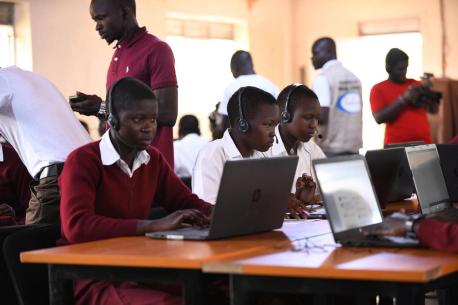
UNICEF
Innovation
From digital innovations to innovative financing tools, the many ways UNICEF stays on the cutting edge of humanitarian work — advancing promising new ideas and increasing its impact for children.
How UNICEF is innovating for children
Within the UNICEF Office of Innovation is a creative, agile, interdisciplinary team tasked with identifying and advancing technologies and practices that strengthen UNICEF’s work, improving how programs and services for the world's children and families are designed, delivered and financed.
UNICEF Innovation fosters collaboration across sectors and borders, building partnerships around “frontier technologies” to drive scalable solutions to global problems.
Digital innovations that accelerate results for children
UNICEF uses new or existing digital technologies and adapts them into solutions to accelerate results for children, including virtual and augmented reality lessons, data and digital health tools that reduce stock-outs of essential commodities, accessible digital textbooks and mobile youth platforms that empower millions of young people.
Innovative financing tools that accelerate UNICEF's impact
UNICEF builds non-traditional mechanisms of raising resources to meet children’s needs such as bridge funds, blended finance, crowdsourcing, catastrophe bonds and cryptocurrency donations.
Physical product innovations to better meet children's needs
UNICEF creates new or improves existing physical goods to meet the needs of children and young people, including portable incubators, accessible latrine slabs for children with disabilities, compressed air for pneumonia, new diagnostic tools and extreme weather-resistant tents to use as emergency shelter or health clinics.
Innovating to improve program efficiency and effectiveness
UNICEF deploys different approaches, processes and ways of working improve efficiency and effectiveness. These innovations include ‘smart’ contracts, human-centered program design, behavior science-driven communication for development, and the use of creative tools to engage adolescents in preparing for emergencies.

Empowering children through innovation
A huge part of the Innovation agenda is to connect the world’s most marginalized populations and to empower young people with access to information, opportunities and choices.
UNICEF uses technology and new approaches to engage young people around the world, connect them to their governments and provide opportunities to ensure that they are future ready.
Principles behind UNICEF's innovative approach
UNICEF's approach to innovation is rooted in the following principles for digital development:
- Involve end users in planning, development and implementation
- Understand the ecosystem being designing for
- Design for scale; be replicable and customizable in other countries and contexts
- Plan for sustainability from the start
- Be data-driven
- Use open-source technology and open data, and invest in software as a public good
- Modify and extend existing tools, platforms and frameworks when possible
- Consider privacy needs and assess and mitigate risks to the security of users and their data
- Be collaborative; engage diverse expertise and work across sector silos
Scaling the successes
UNICEF’s Global Innovation Center (GIC), part of the Office of Innovation, analyzes efforts and scales the successes. The GIC leverages and provides support to a global network of UNICEF offices, specialists and UN organizations in nearly 150 countries.
To date, the GIC has supported 85 countries to identify, adopt and adapt innovative solutions — affecting the lives of over 100 million people.
Help fund innovation programs that work to give children better futures.



